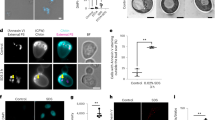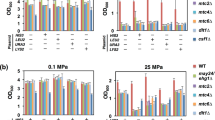Abstract
Cellular ageing is known to correlate with the accumulation of many harmful agents1, but it is unclear whether ageing can also result from the deterioration of components that are beneficial to the cell, but have a low rate of renewal. Here, we report a group of plasma membrane-associated transporters in yeast, belonging to the multidrug resistance (MDR) protein families, that may represent the latter type of ageing determinants. During the division of a yeast cell, newly synthesized transporter proteins are deposited mostly into the growing bud, whereas previously synthesized MDR proteins remain tightly associated with the mother cortex. Thus, the new and old pools of membrane-bound MDR proteins are spatially segregated during yeast asymmetric cell division, with the older pool stably inherited by the ageing mother. A model based on the observed dynamics of MDR protein inheritance and turnover predicted a decline in MDR activity as the mother cell advances in replicative age. As MDR proteins have crucial roles in cellular metabolism, detoxification and stress response, their collective decline may lead to fitness loss at an advanced age. Supporting this hypothesis, mutants lacking certain MDR genes exhibited a reduced replicative lifespan (RLS), whereas introduction of only one extra copy of these MDR genes extended RLS.
This is a preview of subscription content, access via your institution
Access options
Subscribe to this journal
Receive 12 print issues and online access
$209.00 per year
only $17.42 per issue
Buy this article
- Purchase on Springer Link
- Instant access to full article PDF
Prices may be subject to local taxes which are calculated during checkout




Similar content being viewed by others
References
Henderson, K. A. & Gottschling, D. E. A mother's sacrifice: what is she keeping for herself? Current Opinion in Cell Biology 20, 723–728 (2008).
Steinkraus, K. A., Kaeberlein, M. & Kennedy, B. Replicative aging in yeast: the means to the end. Annu. Rev. Cell Dev. Biol. 24, 29–54 (2008).
Mortimer, R. K. & Johnston, J. R. Lifespan of individual yeast cells. Nature 183, 1751–1752 (1959).
Erjavec, N., Larsson, L., Grantham, J. & Nystrom, T. Accelerated aging and failure to segregate damaged proteins in Sir2 mutants can be suppressed by overproducing the protein aggregation-remodeling factor Hsp104p. Genes Dev. 21, 2410–2421 (2007).
Sinclair, D.A. & Guarente, L. Extrachromosomal rDNA circles — a cause of aging in yeast. Cell 91, 1033–1042 (1997).
Park, H.-O. & Bi, E. Central roles of small GTPases in the development of cell polarity in yeast and beyond. Microbiol. Mol. Biol. Rev. 71, 48–96 (2007).
Huh, W.-K. et al. Global analysis of protein localization in budding yeast. Nature 425, 686–691 (2003).
Ernst, R., Klemm, R., Schmitt, L. & Kuchler, K. Yeast ATP-binding cassette transporters: cellular cleaning pumps. Methods Enzymol. 400, 460–484 (2005).
Uemura, T., Tachihara, K., Tomitori, H., Kashiwagi, K. & Igarashi, K. Characteristics of the polyamine transporter TPO1 and regulation of its activity and cellular localization by phosphorylation. J. Biol. Chem. 280, 9646–9652 (2005).
Burke, D. J. & Church, D. Protein synthesis requirements for nuclear division, cytokinesis, and cell separation in Saccharomyces cerevisiae. Mol. Cell. Biol. 11, 3691–3698 (1991).
Spellman, P. T. et al. Comprehensive identification of cell cycle-regulated genes of the yeast Saccharomyces cerevisiae by microarray hybridization. Mol. Biol. Cell 9, 3273–3297 (1998).
Althoefer, H., Schleiffer, A., Wassmann, K., Nordheim, A. & Ammerer, G. Mcm1 is required to coordinate G2-specific transcription in Saccharomyces cerevisiae. Mol. Cell. Biol. 15, 5917–5928 (1995).
Faty, M., Fink, M. & Barral, Y. Septins: a ring to part mother and daughter. Curr. Genet. 41, 123–131 (2002).
Barral, Y., Mermall, V., Mooseker, M. S. & Snyder, M. Compartmentalization of the cell cortex by septins is required for maintenance of cell polarity in yeast. Mol. Cell 5, 841–851 (2000).
Egilmez, N. K. & Jazwinski, S. M. Evidence for the involvement of a cytoplasmic factor in the aging of the yeast Saccharomyces cerevisiae. J. Bacteriol. 171, 37–42 (1989).
Chen, J. B. & Jazwinski S. M. Preparation and partial characterization of old yeast cells. J. Bacteriol. 45, b9–b17 (1990).
Lesur, I. & Campbell, J. L. The transcriptome of prematurely aging yeast cells is similar to that of telomerase-deficient cells. Mol. Biol. Cell 15, 1297–1312 (2004).
Tomitori, H. et al. Multiple polyamine transport systems on the vacuolar membrane in yeast. Biochem. J. 353, 681–688 (2001).
Eisenberg, T. et al. Induction of autophagy by spermidine promotes longevity. Nat. Cell Biol. 11, 1305–1314 (2009).
Morselli, E. et al. Autophagy mediates pharmacological lifespan extension by spermidine and resveratrol. Aging 1, 961–970 (2009).
Kirchman, P. A. & Botta, G. Copper supplementation increases yeast life span under conditions requiring respiratory metabolism. Mech. Ageing Dev. 128, 187–195 (2007).
Cui, Z., Hirata, D., Tsuchiya, E., Osada, H. & Miyakawa, T. The multidrug resistance-associated protein (MRP) subfamily (Yrs1/Yor1) of Saccharomyces cerevisiae is important for the tolerance to a broad range of organic anions. J. Biol. Chem. 271, 14712–14716 (1996).
Burtner, C., Murakami, C., Kennedy, B. & Kaeberlein, M. A molecular mechanism of chronological aging in yeast. Cell Cycle 8, 1256–1270 (2009).
Steffen, K.K., Kennedy, B. K. & Kaeberlein, M. Measuring replicative life span in the budding yeast. J. Vis. Exp. 28, doi: 10.3791/1209 (2009).
Chen, D. & Guarente, L. SIR2: a potential target for calorie restriction mimetics. Trends Mol. Med. 13, 64–71 (2007).
Merry, B.J. Oxidative stress and mitochondrial function with aging—the effects of calorie restriction. Aging Cell 3, 7–12 (2004).
Igarashi, K. & Kashiwagi, K. Polyamines: mysterious modulators of cellular functions. Biochem. Biophys. Res. Commun. 271, 559–564 (2000).
Bunting, K. D. ABC Transporters as phenotypic markers and functional regulators of stem cells. Stem Cells 20, 11–20 (2002).
Burke, D., Dawson, D., Stearns, T. & Cold Spring Harbor Laboratory. Methods in yeast genetics: a Cold Spring Harbor laboratory course manual. (Cold Spring Harbor Laboratory Press, 2000).
Livak, K. J. & Schmittgen, T. D. Analysis of relative gene expression data using real-time quantitative PCR and the 2-ΔΔCT Method. Methods 25, 402–408 (2001).
Acknowledgements
We thank C. Zhou for assistance on RLS experiments; C. Seidel and B. Fleharty for help on RNA purification and quantitative RT–PCR; R. Zhu, K. Wagner and J. Haug for assistamce with cell-sorting experiments and B. Slaughter, N. Pavelka and S. Xia for technical advice and critical comments. This research is supported by the National Institutes of Health, grant R01GM057063 to R.L. The content is solely the responsibility of the authors and does not necessarily represent the official views of the National Institute of General Medical Sciences or the National Institutes of Health.
Author information
Authors and Affiliations
Contributions
A.E. performed all of the experiments and prepared the manuscript figures and draft. G.R. contributed to MDR protein quantification and RLS measurements. B.R. constructed the mathematical model for MDR dynamics during RLS. P.P. and V.C. provided technical assistance for various experiments. R.L. conceived and supervised the project and revised the manuscript.
Corresponding author
Ethics declarations
Competing interests
The authors declare no competing financial interests.
Supplementary information
Supplementary Information
Supplementary Information (PDF 682 kb)
Supplementary Information
Supplementary Movie 1 (MOV 39 kb)
Supplementary Information
Supplementary Movie 2 (MOV 24 kb)
Supplementary Information
Supplementary Movie 3 (MOV 549 kb)
Rights and permissions
About this article
Cite this article
Eldakak, A., Rancati, G., Rubinstein, B. et al. Asymmetrically inherited multidrug resistance transporters are recessive determinants in cellular replicative ageing. Nat Cell Biol 12, 799–805 (2010). https://doi.org/10.1038/ncb2085
Received:
Accepted:
Published:
Issue Date:
DOI: https://doi.org/10.1038/ncb2085
This article is cited by
-
PIFiA: self-supervised approach for protein functional annotation from single-cell imaging data
Molecular Systems Biology (2024)
-
Age-dependent decline in stress response capacity revealed by proteins dynamics analysis
Scientific Reports (2020)
-
Emerging roles for sphingolipids in cellular aging
Current Genetics (2018)
-
Multidrug resistance protein 1 reduces the aggregation of mutant huntingtin in neuronal cells derived from the Huntington’s disease R6/2 model
Scientific Reports (2015)
-
Linking cell polarity, aging and rejuvenation
Biogerontology (2011)



